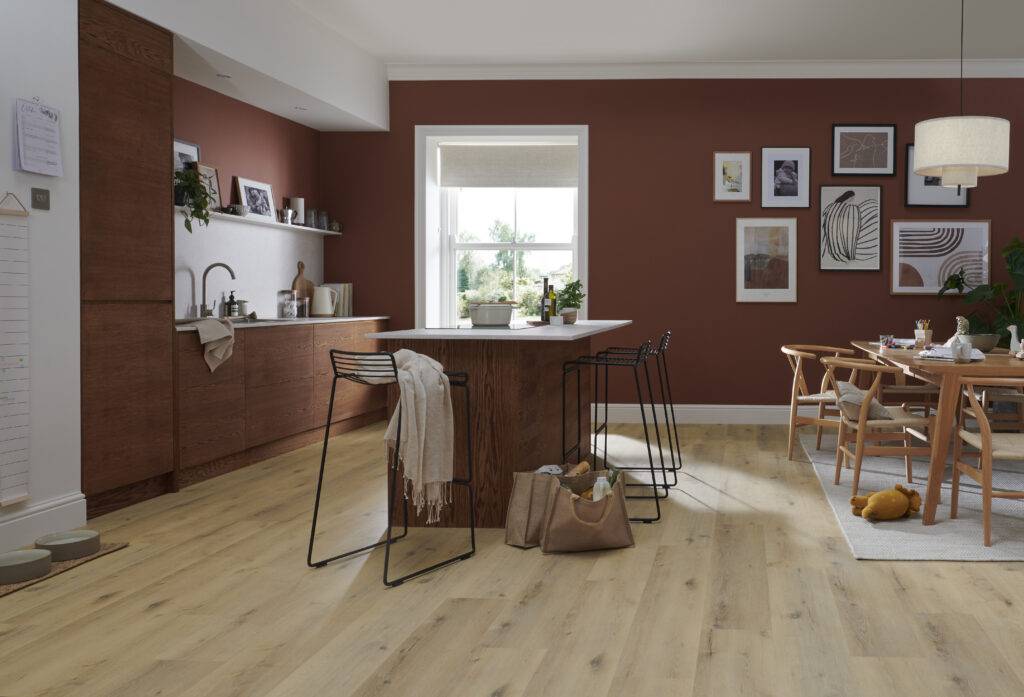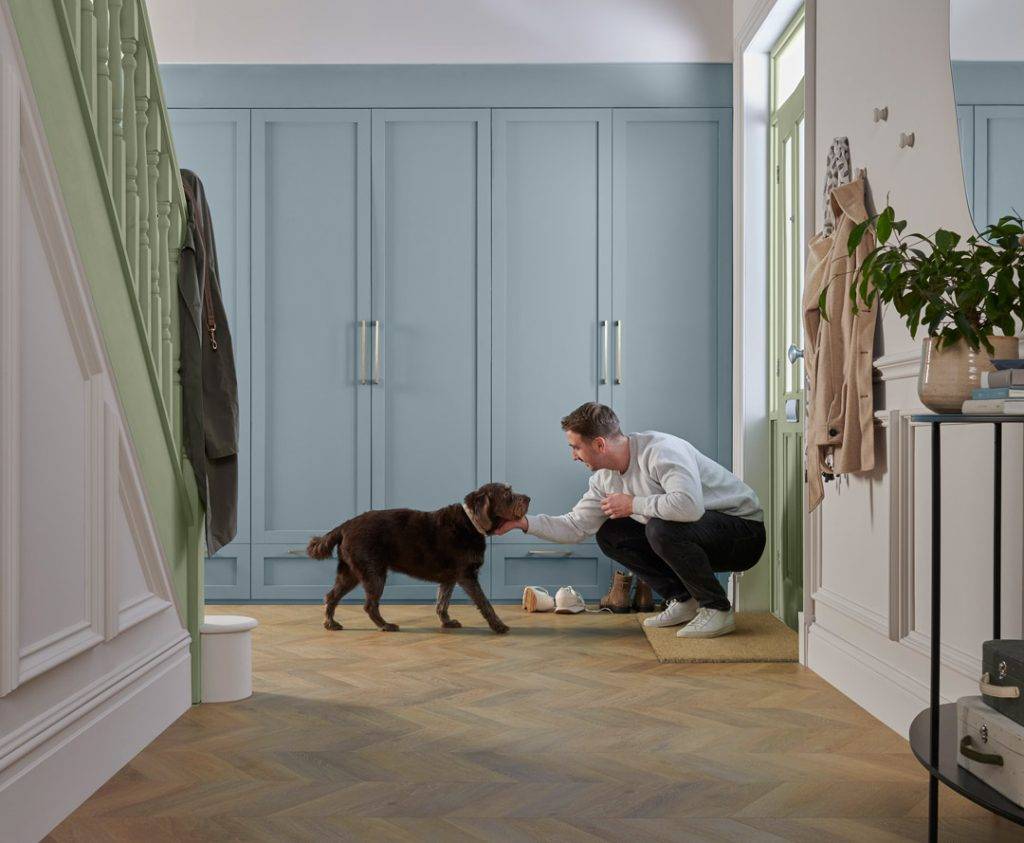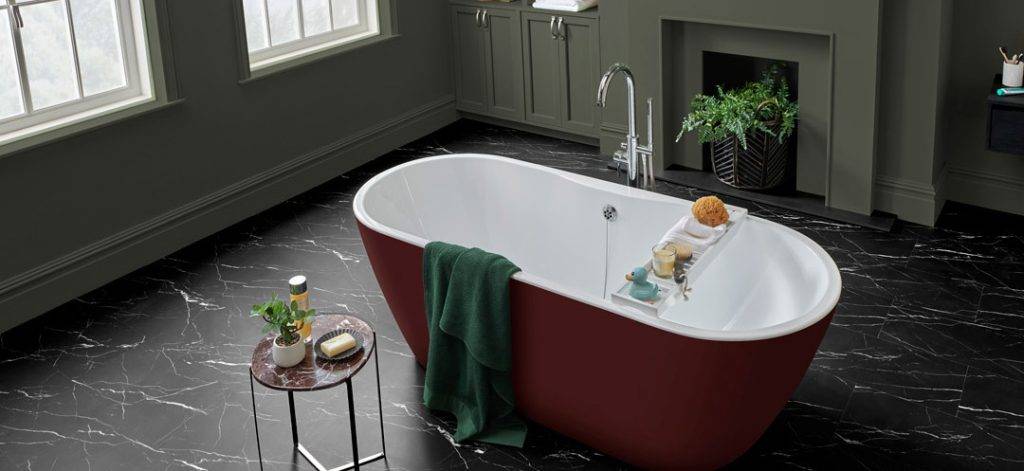Building homes from the floor up
Up to 3 FREE Samples
Building homes from the floor up
Up to 3 FREE Samples
Underfloor heating (UFH) is a heating system that is gaining popularity both in households and the workplace. UFH is an ideal choice for an energy efficient, space-saving, and comfortable heating system to work with your design. But what is the best flooring for underfloor heating?
Not all flooring is suitable with underfloor heating. To achieve maximum functionality and efficiency, make sure your preferred flooring is compatible with your underfloor heating system. Stone and tile, engineered wood, LVT, carpet, laminate, and vinyl roll are all underfloor heating system possibilities.
Your UFH’s efficiency is significant enough to make a huge difference to your comfort, especially in rooms that are notoriously difficult to heat. It eliminates the need for radiators and is used in everything from antique residences with high ceilings to big modern constructions. The extra heat generated by UHF must pass through the floor in order to warm the room, thus the flooring you choose is critical to its efficiency. Here we outline the best flooring for underfloor heating and those you should really avoid.
Preparing your subfloor and ensuring the surface is level is critical when installing any type of flooring. This serves as the basis for your flooring and must be done correctly to avoid problems later on.
In many cases, the subfloor must be damp-proofed, especially if you intend to use a wet system that must be screeded over. When working with underfloor heating, a specialised underlay that is thinner and evenly distributes heat may need to be used. Depending on the type of flooring you choose, a high temperature adhesive may be required as part of the installation process.
The type of flooring you choose is heavily influenced by your underfloor heating system. Some alternatives perform beautifully and maximise efficiency, but others may cause problems in the future. Here’s a list of popular flooring kinds, with descriptions of which perform well with UFH and which should be avoided.
Wood flooring is popular among many individuals. Whether for the house, workplace, or a restoration project, its durability and timeless style are frequently unrivalled. However, when it comes to underfloor heating, solid wood flooring is not the ideal option.
When it comes to temperature fluctuations, solid wood flooring is known to struggle. Excess heat causes wood to expand, which is why solid wood is normally avoided in kitchens. When the temperature drops again, the wood contracts, causing warping. These shifting temperatures are unavoidable if you have underfloor heating, not to mention that wood is a natural insulator, reducing the efficiency of your UHF.
Incompatible flooring can be a significant risk as the heat can warp, buckle or damage the flooring which can void the warranties for both the floor and the UFH. There’s nothing worse than investing in underfloor heating, picking the perfect flooring for your design and then finding that the two are incompatible.
With these considerations in mind, it’s simple to see why solid wood flooring is best avoided when combined with underfloor heating.
Cork flooring is a popular eco-friendly option that has grown in popularity in recent years. However, because many vendors claim that their cork flooring is appropriate for underfloor heating, this is one flooring option that can be misleading. Although this may be the case, there are a few consideration elements you should take into account.
Cork, like wood, is a natural insulator. This means that laying it over your UHF could potentially reduce its impact and cause less heat to flow. The additional heat may also allow your cork flooring to dry out faster.
While a thick carpet is most people’s preferred choice for comfort, a dense pile and underlay limits efficient heat transfer. The thickness of materials above underfloor heating is important. If you lay a carpet on top of underfloor heating, then the combined warm air resistance of both the underlay and carpet should not go over 2.5 togs. Anything above this would reduce the efficiency of your UHF system.
Engineered wood flooring can be a good option, but it’s important to remember to get a type that has thermally conductive properties to make sure that the heating from the heating pipes or elements is transferred through the flooring.
Generally engineered wood is less affected by temperature fluctuations than solid wood flooring since it is made up of multiple layers. Generally, temperatures should not exceed 27°C. and the temperature should be increased gradually over a period of 7 days up to the optimal room temperature when first placed to allow the flooring to adjust to the heat.
Engineered wood boards are extremely stable due to a core board comprised of ply layers that is then finished off with a solid wood top layer. To be UHF compatible, the top layer should be no thicker than 5mm and the total board should be no thicker than 18mm. This is done to allow heat to move through effectively and ascend.
Ceramics and stone are among the most efficient heat conductors available as they have excellent thermal properties and help to retain heat in the room. They are, however, less comfortable and more expensive to repair if they are damaged, so this choice is dependent on your entire budget.
If you wish to use tiles or stone with underfloor heating, you can determine the thickness you want based on its conduction – obviously within reason.
Due to the nature of stone floors, it can take longer and cost more to heat a room using underfloor heating.
Laminate Flooring, like Engineered Wood, employs numerous layers to provide a sturdy and lasting flooring solution. To achieve the best efficiency, the overall board thickness should be no more than 18mm, and the temperature should not exceed 27°C (80.6 °F).
The layers of high-density fibreboard (HDF) are covered with a wood-chip composite that resembles wood by using a printed image.
If a wet underfloor heating system is used and bursts, laminate, due to its composition is more likely to absorb and retain the moisture, causing the flooring to swell and disform.
Luxury Vinyl Tile (LVT) is a popular option since it is waterproof, easy to clean, and long-lasting. It’s available in a wide variety of design choices, and also more comfortable than many other types of flooring. It’s waterproof ability makes it an excellent choice for anywhere in the home, but especially kitchens or bathrooms.
LVT flooring, like most flooring that is compatible with underfloor heating, can effectively conduct heat and is able to endure temperatures up to 27°C, though this can vary from manufacturer to manufacturer. LVT can perfectly mimic the look of real wood flooring without interfering with the efficacy of your UFH system. It’s a win-win scenario.
Whilst LVT planks and tiles themselves are waterproof, the method of the installation and types of product used determines if the floor is water resistant or waterproof. If the product isn’t physically jointed and sealed, it will be water resistant. If the product is installed using a waterproof adhesive the installation will be waterproof. The areas that won’t be waterproof are the skirting boards, floor boards, untreated concrete subfloors etc.
Rolled vinyl flooring can be laid over most underfloor heating systems, making it an affordable option. It is particularly well suited to areas such as the bathroom or kitchen.
The thinness of vinyl roll means that heat can easily pass through the floor covering to heat the room. Before installing vinyl over an underfloor system you need to ensure the area is dry so there is no moisture beneath the flooring which could lead to bubbling or even mould.
If you insist on having the comfort of carpet over underfloor heating, you should ensure it is not too thick so as to limit heat transfer. The thickness of the carpet and any underlay will make a significant difference, so choose carefully and ensure they have a combined tog rating of under 2.5 tog.
Carpets with hessian backing are recommended for use with underfloor heating systems. While this will be a more expensive option than secondary-backed flooring, it will allow the heat to travel through the carpet whereas the adhesive between the carpet and backing will tend to keep the heat beneath the floor.
Yes
No/not ideal
With all of the above factors considered, there is no simple answer to this question. It all relies on your own scenario, and a variety of determining elements must be considered before making your decision.
The type of underfloor heating system you have will have a major bearing, so you need to choose carefully to ensure your flooring is compatible. The room in which you will lay the flooring, the temperature of your region, and, of course, your budget all play a role in selecting the right option for you and your home.
If you are unsure which option to choose, then factors such as durability will come into play as well as the ability to allow heat transfer. An option such as LVT can be the perfect solution, providing a flooring type that is attractive, hard wearing, easy to clean, waterproof and yet is suitable for use above most underfloor heating systems.
You should always ensure that the underfloor heating system is compatible with your choice of floor covering.
Luvanto LVT is a great choice for most floors with underfloor heating. To ensure efficient transfer of heat you should choose a flooring that is not overly thick. A thickness of around 2-3mm would usually be the ideal choice as it provides the right level of comfort while still allowing the underfloor heating to heat your floor and radiate throughout the room efficiently.
In general Luvanto LVT is suitable for a range of UFH systems including:
As there are numerous underfloor heating systems on the market, each with varying guidelines, it is near impossible for us to provide comprehensive advice about laying Luvanto LVT over every UFH system. We strongly recommend that you consult your manufacturer for detailed instructions and ensure your underfloor system is suitable for use with vinyl tiles (LVT) before making the commitment.
Recently Viewed
Related Articles
The Natural LVT flooring trend: Bring the Outdoors in
Crafting Industrial Style: Decorating with Stone Effect LVT Flooring from Luvanto
How to Style Dark Flooring
How to Style Herringbone Flooring
Understanding LVT Specifications and Technical Details: Your Guide to a Perfect Floor
Waterproof LVT for High-Moisture Bathrooms
Clay Earth
Midnight Olive
Coastal Cottage




Trends come and go but a Luvanto floor is forever.
Keep your interiors looking show-home worthy with our colour and trend inspiration. As experts in colour forecasting and pairings, we match the latest trends and colours with each of our flooring shades so you can stay tickled pink with your décor all year round.
Flooring
Inspiration
Where To Buy
Help And Support
Copyright © 2024 Luvanto - QA Flooring Solutions Ltd. All Rights Reserved.
QA Flooring Solutions Ltd is a company registered in England
Registered Office: Unit 2 Hurricane Drive, Speke, Liverpool, L24 8RL
Company Registration Number: 07870268 | VAT Number: 852026449
| Cookie | Duration | Description |
|---|---|---|
| cookielawinfo-checkbox-analytics | 11 months | This cookie is set by GDPR Cookie Consent plugin. The cookie is used to store the user consent for the cookies in the category "Analytics". |
| cookielawinfo-checkbox-functional | 11 months | The cookie is set by GDPR cookie consent to record the user consent for the cookies in the category "Functional". |
| cookielawinfo-checkbox-necessary | 11 months | This cookie is set by GDPR Cookie Consent plugin. The cookies is used to store the user consent for the cookies in the category "Necessary". |
| cookielawinfo-checkbox-others | 11 months | This cookie is set by GDPR Cookie Consent plugin. The cookie is used to store the user consent for the cookies in the category "Other. |
| cookielawinfo-checkbox-performance | 11 months | This cookie is set by GDPR Cookie Consent plugin. The cookie is used to store the user consent for the cookies in the category "Performance". |
| viewed_cookie_policy | 11 months | The cookie is set by the GDPR Cookie Consent plugin and is used to store whether or not user has consented to the use of cookies. It does not store any personal data. |
Building homes from the floor up
Up to 3 FREE Samples